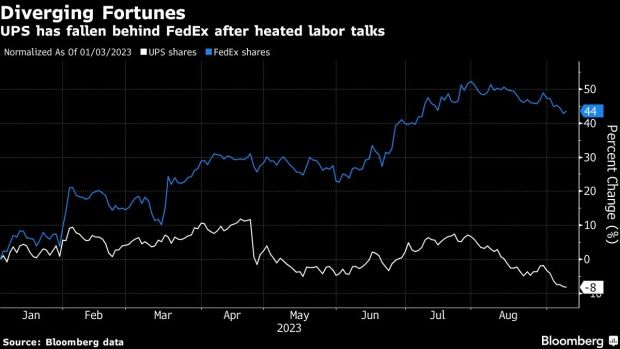UPS Chief Says Year One of Pricey New Labor Deal Will Hurt Most ...

(Bloomberg) -- United Parcel Service Inc. will pay out the biggest portion of its new, five-year labor pact over the next 12 months while trying to win back customers it lost during the contentious contract talks, making for a challenging upcoming year, its chief executive said.
The company will offer some customer-service improvements and lean into automation, UPS Chief Executive Officer Carol Tomé said Monday in an interview. That could help it boost sales and save money as it covers the large, initial pay rise Teamsters secured in a labor deal that took effect in August.
Meanwhile, the end of a pandemic-related package-shipping boom has put pressure on the industry overall. The broader slump and the unique cost strain that UPS faces as a result of the labor pact have already made for a tough few months. UPS shares have slid almost 7% in 2023 while rival FedEx Corp. has soared almost 50% by outlining its own cost cuts and snapping up customers who dropped its competitor during labor negotiations.
“We put more cost in our business this year than we had anticipated, in an environment where the volume has receded,” Tomé said. “That puts some pressure on the margin, which is reflected, I think, in the share price.”
Adding Automation
The CEO believes UPS can reach a 12% operating profit margin in the US by implementing her cost-cutting and customer-wooing plans, even with the higher labor expenses. That would be only slightly higher than earlier in the year, but far higher than the 8.3% analysts expect this quarter. Tomé declined to give a time frame for the goal.
UPS will achieve some of the savings by introducing new technology into its facilities, a right the company retained during worker negotiations.
The company has put radio-frequency identification tags on packages, reducing the rate of misloaded items. The tags also allow the trucks to scan parcels, a task usually reserved for people. And UPS is using automation to unload trucks and driverless tugs to move heavy loads.
“We are not taking our eye off of the productivity ball,” Tomé said.
UPS will hold an investor meeting in the spring to give more details on how it will improve margins.
By the fall, boosting profitability should become slightly easier as pay rises shrink. UPS has to cover 46% of the Teamster agreement’s total cost increase in the first year. But on average, UPS’s labor costs will only rise 3.3% a year over the life of the deal. Tomé said the overall expense was within the company’s budget, though she didn’t expect the arrangement to be so front-loaded.
Read More: UPS ‘Blinked’ and the Teamsters Notched a $30 Billion Win
Lost Customers
The talks with the Teamsters also created another challenge for Tomé. UPS said in August that the heated discussions caused about 1.2 million packages per day of lost volume — either directly to competitors or new business that didn’t occur.
With rising cost pressure, UPS has opted to recover those customers with better service, rather than discounts.
Tomé said UPS has told at least 200 of its largest customers that it won’t cap the volume of items they ship during the upcoming, busy holiday season. UPS put caps in place throughout the pandemic to avoid getting overwhelmed, though shipping demand has since slid. The company, and rival FedEx, both said they’d increase prices by 5.9% in 2024.
“We’ve got a cost increase that’s coming at us, so we’ve got to manage through and we will,” Tomé said. “I’m telling you, come September of ‘24, hubba hubba, we’re going be past that cost increase and it’s gonna be a lot easier from that point going forward.”
©2023 Bloomberg L.P.





















































